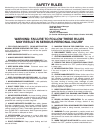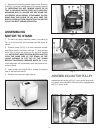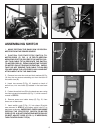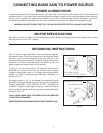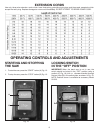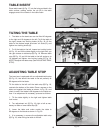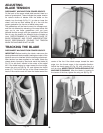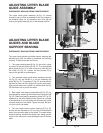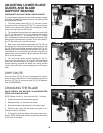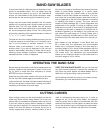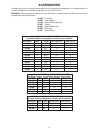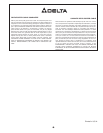
13
BAND SAW BLADES
A band saw blade is a delicate piece of steel that is sub-
jected to tremendous strain. You can obtain long use
from a band saw blade if you give it fair treatment. B
ensure you use blades of the proper thickness, width,
and temper for the various types of material to be cut.
Always use the widest blade possible. Use the narrow
blades only for sawing small, abrupt curves and for fine
delicate work. This will save blades and will produce
better work. Band saw blades may be purchased, weld-
ed, set and sharpened ready for use. For cutting wood
and similar materials, Delta supplies blades in widths of
1
/8,
3
/16,
1
/4,
3
/8,
1
/2, and
3
/4 inches.
File and set the wood cutting blades whenever you find
it requires pressure to make them cut. If a blade is bro-
ken it can be brazed or welded; however, if it has
become badly work-hardened, it will soon break in
another place. If you are not equipped to file, set and
braze or weld blades, take them to a saw filer for recon-
ditioning. Under average conditions, blades should be
resharpened after 4 hours of operation.
Any one of a number of conditions may cause a band saw
blade to break. Blade breakage is, in some cases,
unavoidable, being the natural result of the peculiar
stresses to which such blades are subjected. It is, how-
ever, often due to avoidable causes, most often to lack of
care or judgment on the part of the operator in mounting
or adjusting the blade or guides. The most common
causes of blade breakage are: 1) faulty alignments and
adjustments of the guides; 2) forcing or twisting a wide
blade around a curve of short radius; 3) feeding too fast;
4) dullness of the teeth or absence of sufficient set; 5)
excessive tightening of the blade; 6) top guide set too
high above the work being cut; 7) using a blade with a
lumpy or improperly finished braze or weld; and 8) con-
tinuous running of the saw blade when not in use for cut-
ting.
New blades for the standard 14-inch Band Saw are
93
1
/2 inches long. The adjustment will accommodate
blades up to a maximum length of 94 inches and to a
minimum length of 91
1
/2 inches. When equipped with the
No. 28-984 Height Attachment, new blades should be
105 inches long. The adjustment will accommodate
blades up to a maximum length of 106 inches and to a
minimum length of 103
1
/2 inches.
OPERATING THE BAND SAW
Before starting the machine, see that all adjustments are
properly made and the guards are in place. Turn the pul-
ley by hand to make sure that everything is correct
BEFORE turning on the power.
Keep the top guide down close to the work at all times.
Do not force the material against the blade too hard.
Light contact with the blade will permit easier following of
the line and prevent undue friction, heating, and work-
hardening of the blade at its back edge.
KEEP THE SAW BLADE SHARP and you will find that
very little forward pressure is required for average cut-
ting. Move the stock against the blade steadily and no
faster than will give an easy cutting movement.
Avoid twisting the blade by trying to turn sharp corners.
Remember, you must saw around corners.
CUTTING CURVES
When cutting curves, turn the stock carefully so that the
blade may follow without being twisted. If a curve is so
abrupt that it is necessary to repeatedly back up and cut
a new kerf, either a narrow blade is needed or a blade
with more set is required. The more set a blade has, the
easier it will allow the stock to be turned, but the cut is
usually rougher than where a medium amount of set is
used. In withdrawing the piece being cut, in order to
change the cut, or for any other reason, the operator
must be careful that he does not accidentally draw the
blade off the wheels. In most cases it is easier and safer
to turn the stock and saw out through the waste materi-
al, rather than try to withdraw the stock from the blade.



